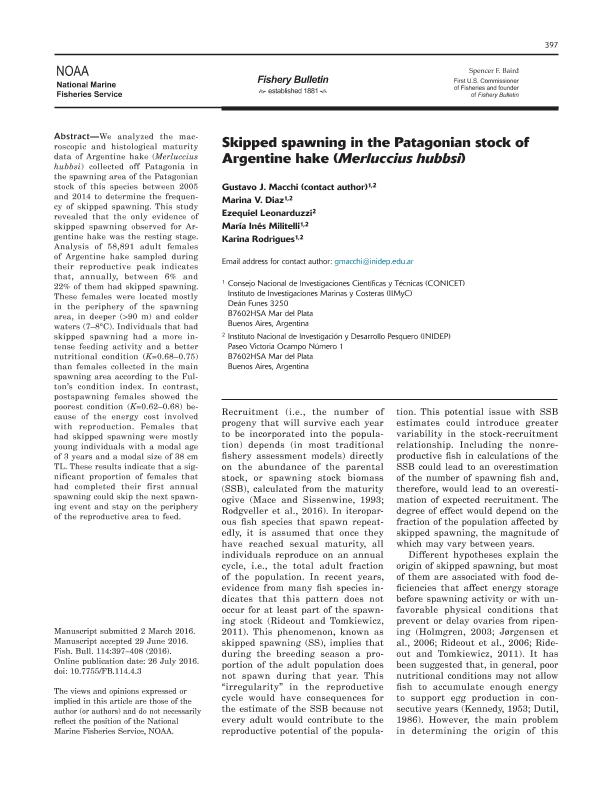Artículo
Skipped spawning in the Patagonian stock of Argentine Hake (Merluccius hubbsi)
Macchi, Gustavo Javier ; Diaz, Marina Vera
; Diaz, Marina Vera ; Leonarduzzi, Ezequiel; Militelli, Maria Ines
; Leonarduzzi, Ezequiel; Militelli, Maria Ines ; Rodrigues, Karina Andrea
; Rodrigues, Karina Andrea
 ; Diaz, Marina Vera
; Diaz, Marina Vera ; Leonarduzzi, Ezequiel; Militelli, Maria Ines
; Leonarduzzi, Ezequiel; Militelli, Maria Ines ; Rodrigues, Karina Andrea
; Rodrigues, Karina Andrea
Fecha de publicación:
07/2016
Editorial:
NOAA's National Marine Fisheries Service. Scientific Publications Office
Revista:
Fishery Bulletin
ISSN:
0090-0656
Idioma:
Inglés
Tipo de recurso:
Artículo publicado
Clasificación temática:
Resumen
We analyzed the macroscopic and histological maturity data of Argentine hake (Merluccius hubbsi) collected off Patagonia in the spawning area of the Patagonian stock of this species between 2005 and 2014 to determine the frequency of skipped spawning. This study revealed that the only evidence of skipped spawning observed for Argentine hake was the resting stage. Analysis of 58,891 adult females of Argentine hake sampled during their reproductive peak indicates that, annually, between 6% and 22% of them had skipped spawning. These females were located mostly in the periphery of the spawning area, in deeper (>90 m) and colder waters (7–8°C). Individuals that had skipped spawning had a more intense feeding activity and a better nutritional condition (K=0.68–0.75) than females collected in the main spawning area according to the Fulton’s condition index. In contrast, postspawning females showed the poorest condition (K=0.62–0.68) because of the energy cost involved with reproduction. Females that had skipped spawning were mostly young individuals with a modal age of 3 years and a modal size of 38 cm TL. These results indicate that a significant proportion of females that had completed their first annual spawning could skip the next spawning event and stay on the periphery of the reproductive area to feed.
Archivos asociados
Licencia
Identificadores
Colecciones
Articulos(CCT - MAR DEL PLATA)
Articulos de CTRO.CIENTIFICO TECNOL.CONICET - MAR DEL PLATA
Articulos de CTRO.CIENTIFICO TECNOL.CONICET - MAR DEL PLATA
Articulos(IIMYC)
Articulos de INSTITUTO DE INVESTIGACIONES MARINAS Y COSTERAS
Articulos de INSTITUTO DE INVESTIGACIONES MARINAS Y COSTERAS
Citación
Macchi, Gustavo Javier; Diaz, Marina Vera; Leonarduzzi, Ezequiel; Militelli, Maria Ines; Rodrigues, Karina Andrea; Skipped spawning in the Patagonian stock of Argentine Hake (Merluccius hubbsi); NOAA's National Marine Fisheries Service. Scientific Publications Office; Fishery Bulletin; 114; 4; 7-2016; 397-408
Compartir
Altmétricas



